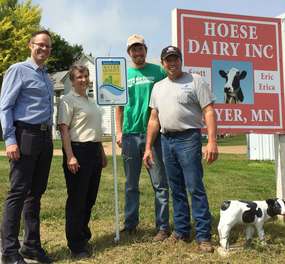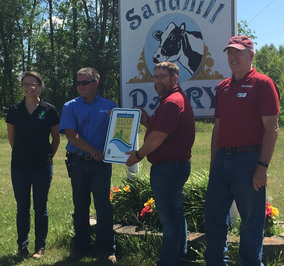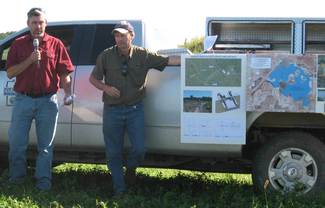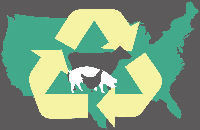 Hoese Dairy first in Carver County
The Hoese Dairy recently became the first farm in Carver County to become certified in the Minnesota Agricultural Water Quality Certification Program. The fifth generation dairy also raises alfalfa, corn, beans and small grains. Conservation
practices include filter strips, conservation cover, precision nutrient
management, and soil health building practices such as perennials crops and
cover crops. Photo: MDA Assistant Commissioner Matt Wohlmann, MPCA Assistant Commissioner Rebecca Flood, Scott and Eric Hoese.
The MAWQCP is a voluntary opportunity for farmers and agricultural landowners to take the lead in implementing conservation practices that protect our water. Those who implement and maintain approved farm management practices will be certified and in turn obtain regulatory certainty for a period of ten years.
|
 Dombecks certified in Otter Tail County
A north
central Minnesota Agricultural Water Quality Certification event held recently at the Bob and Tiffany Dombeck's Sandhill
Dairy and Toad River Farms near Perham recognized them for their efforts of protecting Minnesota's water quality and their
successful completion of Minnesota's Agricultural
Water Quality Certification process.
The Dombecks
use cover crops on irrigated edible beans, corn silage and potato
crops. They follow the University of Minnesota Nutrient Best Management
Practices for corn and edible beans, are reducing tillage and deferring
tillage to spring. In addition, they have installed buffers to
address the water resource concerns.
The Dombeck's farm operations join 447 farm operations in Minnesota who have achieved Water Quality Certification status representing 260,720 acres. More than 807 new conservation practices have been implemented since the program went statewide two summers ago. Pictured: Brittany Johnson, East Otter Tail SWCD; Bob Dombeck; Darren
Newville and Jim Lahn, both with EOT SWCD.
Back to top
|
 For crop producers interested in trying cover crops, some of the best advice comes from the handful already doing it. Along with all the technical stuff, they'll say 'stay out of the coffees shops' and 'get past the skepticism of neighbors'.
More than 75 farmers and agency staff turned out June 29 in Renville for a 'benefits of cover crops' meeting hosted by the Hawk Creek Watershed Project and Renville County SWCD. A panel of area farmers successfully using cover crops described their experiences and challenges. "After 40 years of conventional farming, this is upside down," said one panelist. "It's a huge learning curve" and start small. Photo, L-R: Brian Pfarr, Dawn and Grant Breitkreutz (with microphone), Brad Nere, and Brian Ryberg. Also participating: Kyle VanOverbeke and Joel Timm.
Survey feedback: 'We learned a lot'
"We had a lot of positive feedback with over 60% of post-meeting survey respondents saying they learned a great deal," says Heidi Rauenhorst, Hawk Creek coordinator. "They liked the visual demonstrations (presented by Holly Hatlewick, Renville SWCD administrator) of the slake test and rainfall simulator to see for themselves the difference in healthy soil and unhealthy soil." Comments about what they learned included:
- Ripple effects of increased soil health,
- Benefits of strip/no-till versus conventional tillage,
- Different options for cover crop species,
- Equipment modifications used to interseed cover crops,
- Incorporating livestock into a cover cropping operation had huge benefits,
- Seeing soil structure and organic matter differences in healthy and unhealthy soils,
- Resources available to help with cover crops (seed sales, SWCD, HCWP, other farmers),
- Effects of herbicides and timing on cover crops,
- Differences in water infiltration rates of healthy versus unhealthy soils,
For more information see the Dept. of Agriculture cover crop webpage.
Back to top
|
 Straddling three major watersheds, Kandyohi County in central Minnesota provided a variety of water quality demonstrations for the annual summer tour of the Board of Water and Soil Resources. Wednesday, Aug. 23, they visited sites including the "Squashed Frog" RIM project, water quality improvement at Diamond Lake, Rasmus Lake RIM/WRP project, and Grass Lake restoration.
Surrounded by rural residential and cropland areas, the projects show how water management practices in agricultural areas can support ag production and water quality objectives. The watersheds on the tour included Middle and South Fork Crow, Hawk Creek, and Chippewa.
As the state's soil and water conservation agency, BWSR administers programs that prevent sediment and nutrients from entering our lakes, rivers, and streams; enhance fish and wildlife habitat; and protect wetlands. The 20-member board consists of representatives of local and state government agencies and citizens. Photo: Loren Engelby of Kandiyohi County, left, and Tom Wenzel of BWSR describe the Grass Lake restoration project southeast of Willmar.
Back to top
|
 From the Livestock and Poultry Environmental Learning Center newsletter: The September webinar topic is very timely - manure safety. As fall
application starts to ramp up, it is important to remember how to keep
yourself, those working with you, and animals safe. A flyer will be posted at
"Upcoming
Webcasts" as soon as it is available.
Water Quality
- Measurements of the "dead zone" in the Gulf
of Mexico indicate 2017 is the largest ever measured at 8,776 square
miles. High discharge rates from the Mississippi River were earlier
predicted to result in a large hypoxic zone. The average size over the
past five years has been just over 5,800 square miles. The target size is
1,900 square miles. Read
more...
- To
help track the science related to agricultural operations and Great Lakes
harmful algal blooms and hypoxia, the National Agricultural Library has created
an online, automatically updated bibliography on the topic. "Great
Lakes Harmful Algal Blooms (HABs) and Hypoxia: Agricultural Aspects"
is not a complete listing of all literature and does include some citations
that may not have a strict agriculture focus.
- University
of Illinois researcher, Laura Christianson, is studying woodchip bioreactors,
not only for their ability to remove nitrogen from runoff, but also phosphorus.
How? She and a research team looked at the addition of a "P filter"
either before or after the bioreactor. Neither placement affected the ability
of the bioreactor to remove nitrogen. The amount of P removed varied depending
on the material used in the filter. News
release... | Journal
article...
- EPA,
along with several partners, has announced a "Nutrient Sensor Action
Challenge" with the goal of accelerating the development of affordable
continuous sensors. The first stage of submissions closes September 20, 2017. Learn
more or view the archived informational webinar...
Soil Health
Back to top
|
Karen Pressley started Aug. 13 as the new County Feedlot Officer in Jackson County.
Back to top
MPCA releases its proposal for protecting wild
rice from excess sulfide
News release, 8/21/17
AGRI grants help farmers test new ideas to drive sustainability
News release, 8/17/17
Hog facility in Mower County looking to expand production, environmental review underway
News release, 8/9/17
Comment period on nitrogen fertilizer rule ends August 25
News release, 8/17/17
Drainage technology, cover crops help to curb nutrient loss
Illinois Farmer Today, 8/19/17
Back to top
Sept. 6: Strip till expo, 8:30-2:30, includes lunch, Piekarski farm, 24678 County Hwy 11, Fergus Falls.
Sept. 8: Cover crop and soil health learning tour, Brunk Farm, 23068 220th St., Rushmore.
If you know of other field day events for this calendar, please contact Forrest Peterson, 320-441-6972, forrest.peterson@state.mn.us. Thanks!
Back to top
Sept. 20-21: Animal
nutrition conference, City
Center Hotel, Mankato.
Sept. 26: Ag and Animal
Science Conference,
MinnWest Technology Campus, Willmar.
Oct. 17-18: Minnesota Water Resources Conference, St. Paul
RiverCentre.
Back
to top
The
MPCA Feedlot Update welcomes news from partners about, projects, people, and
upcoming events. Email submissions to forrest.peterson@state.mn.us.
Past issues of Feedlot Update are available on the feedlot program publications webpage.
|